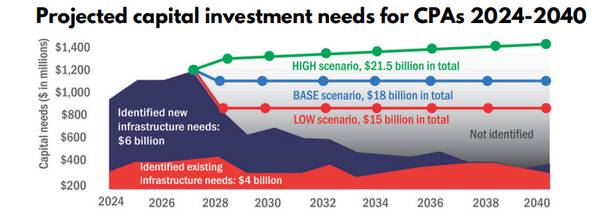
Canada’s ability to expand and diversify international trade as a reliable trading partner hinges on significant port infrastructure investment in the coming years, according to the Port Infrastructure Needs Assessment, from the Association of Canadian Port Authorities (ACPA).
The report projects as much as $21.5 billion in needed investments will need to be made by Canada Port Authorities (CPAs) by 2040.
The study examined the projected capital requirements of the 17 CPAs, which are federally owned but operate at arm’s length of government. The study shows that CPAs have $10 billion in planned investments over the next 15 years, with $5 billion required in the next four years alone. However, funding has not yet been identified for 61% of those investments.
Long-term needs are uncertain due to a limited ability to plan beyond five years, but total requirements through 2040 are estimated from $15 to $21.5 billion. Canada’s port authorities received about $1 billion from the National Trade Corridors Fund (NTCF). The fund helped many CPAs fortify Canada’s global trade infrastructure. However, given the federal government’s fiscal constraints and the level of future investment needed, federal infrastructure funding alone cannot meet the challenge.
Top recommendations in the study to provide CPAs greater agility include:
• Streamlining the regulatory review process for environmental assessments.
• Modernizing CPA borrowing limits and how they are raised.
• Increasing flexibility for joint ventures with other CPAs and private partners.
• Establishing a permanent federal funding program for trade infrastructure and major equipment to fill gaps that private investment cannot address.
Future investments are needed to update infrastructure, meet trade diversification goals and ensure economic and national security. Most port infrastructure investments are for operational efficiency (82%) and expansion/growth (79%). Other key projects address aging infrastructure (48%), decarbonization (39%), climate adaptation (30%), and supply chain optimization (19%).
Canada’s ports and marine shipping are indispensable to Canada’s economic security, with 80% of global goods shipped by water. According to data released by Statistics Canada on January 7, 2025, ports are responsible for 18% of exports, worth $139 billion and 24% of imports, worth $181 billion.
"There is significant demand in the world for what Canada has to offer, but to get it to global markets Canada needs ports with greater agility. This study highlights the need for Canada’s port authorities to have access to more flexible financial tools to leverage private capital projects for major projects and streamlined project reviews to make them happen responsibly, but much more quickly," said Daniel-Robert Gooch, ACPA President and CEO. "By reducing red tape and enabling port authorities to move more swiftly on major infrastructure projects, Canada’s ports can enhance their competitiveness and better collaborate with private partners to diversify global trade."



